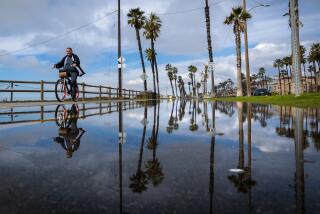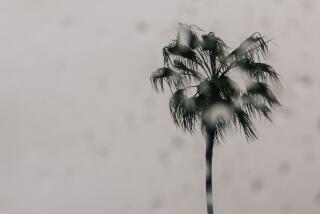Nora Leaves Rain, Flooding in Its Wake
Still-powerful remnants of former Hurricane Nora invaded Southern California from Mexico Thursday, triggering floods, knocking out electrical power, snarling traffic and generating tide-boosted waves that swamped several homes in Seal Beach.
Nora, downgraded to a tropical storm as it moved inland, still packed quite a punch, dumping as much as two inches of rain in the low-lying Imperial Valley and up to four inches in the mountains of San Diego, Riverside and San Bernardino counties.
Rainfall was generally lighter, but still substantial, in Los Angeles and Orange counties, where the circulating fringes of the cyclonic tropical storm dropped generally gentle but persistent showers throughout the area.
In the San Fernando Valley region, there was scattered flooding and three accidents involving big trucks that slowed traffic for hours on the Golden State and Antelope Valley freeways.
Light sprinkles began falling on Los Angeles shortly before dawn Thursday, ending a dry spell that had lasted a record-shattering 219 days. The 0.45 of an inch of rain that had fallen on the Civic Center by nightfall was the first measurable precipitation since Feb. 17, when 0.02 of an inch fell downtown. The old record--197 days--was set between April 12 and Oct. 27 in 1927.
Nora’s diminishing strength spared Southern California the sort of widespread devastation that the storm had wreaked on Mexico’s Baja California while still a hurricane.
The worst problems in the Los Angeles area apparently occurred in the Orange County community of Seal Beach, on the outer fringes of the storm.
Orange County officials said high tides boosted waves generated by Nora and a storm far to the north, sending breakers 20 feet tall crashing into beachfront homes in low-lying areas of the city.
Three houses were seriously damaged and 45 others received minor damage as water gushed through garages and patios.
Dave West, who lives on 12th Street, bolted out of bed at 4 a.m., thinking, at first, that an earthquake had occurred.
“I heard a rush of water and felt a pounding,” West said. “I looked outside and the water was streaming across the street. . . . By 6 a.m. I had two feet of water in the hallway,” West said.
Sleepy residents and barefoot surfers scrambled to fill and stack sandbags, while bulldozers hastily constructed a sand berm that stretched for six blocks in front of the flooded area. Workers ferried sandbags by kayak to nervous residents.
The long dry spell had allowed grease and oil residues to build up on Southern California’s streets and freeways, and Nora’s sprinkles turned the roadways into tropical skating rinks during the morning rush hour.
The California Highway Patrol said there were about 230 traffic accidents on Los Angeles-area freeways between 4 and 10 a.m. The rush-hour crush lasted almost until noon as commuters struggled to get around jackknifed trucks and multi-car pileups.
In the northern part of the county, the first of three accidents involving semitrailer trucks occurred about 7 a.m. in the southbound lanes of the Golden State Freeway near the Antelope Valley Freeway junction.
One of the trucks lost control in a tunnel and careened off both walls, said Doug Sweeney of the CHP. A car and a van behind the truck tried to avoid it and also lost control, bouncing off the sides of the tunnel before coming to a halt. Each was then rear-ended by other large trucks.
One person suffered minor injuries, and the lanes were closed until noon, Sweeney said.
As those lanes were opening, however, another truck lost control in the northbound truck lanes of the freeway, spilling 300 gallons of diesel fuel, Sweeney said. The truck lanes were expected to be closed until 8 p.m. as Caltrans crews cleaned up the spill.
In a third accident, the southbound over-crossing at the Antelope Valley Freeway and Angeles Forest Highway was shut down for about an hour after a truck there slid out of control, landing on its side.
No injuries were reported.
The Los Angeles Fire Department dispatched rescue crews just before 9 a.m. after it was reported that a person--possibly a child--was floating down a wash near Kittridge Street and Wilbur Avenue. It turned out to be a false alarm, but department spokesman Jim Wells seized on the report as an opportunity to warn parents to keep their children away from flood control channels.
“Parents should remind their children now to stay away from running water,” Wells said. “It’s not a playground.”
Residents of Yuma, where the storm entered the United States, had prepared for the worst, piling up more than 75,000 sandbags to divert what many had predicted would be a devastating flood. School was canceled, city employees were put on emergency alert, and residents in 240 homes in the farm community of Somerton, near the Mexican border, were evacuated to a Red Cross shelter.
The flooding came, but it was confined mostly to streets and low-lying vacant lots. By midafternoon, the sky had brightened, the rain had stopped, and workers were able to rest.
“I think we’re going to survive,” said Roger Brooks, an official with the city/county emergency response team. “We’ve been preparing for the worst, but the worst didn’t happen.”
The same sense of relief was evident in California’s nearby Imperial Valley. Streets were flooded, 35,000 sandbags were deployed, and minor structural damage was reported in Heber, Seeley and Salton City, but Nora was not as wicked as predicted.
However, agricultural officials in Imperial County, which provides a large share of the nation’s winter produce, estimated that the storm did $4 million in crop damage, mostly to lettuce, carrots, broccoli and cauliflower. That damage could increase if mold sets in, the officials said.
The light rain, coming after the lengthy dry spell, led to “flashovers” that briefly knocked out electrical service to about 40,000 customers in the city and 85,000 in surrounding communities, according to officials with the Department of Water and Power and the Southern California Edison Co.
Most of the outages in the city occurred near downtown, Hollywood, North Hollywood and Lincoln Heights. Most customers had power restored within a few hours, officials said.
Health officials issued a rainy-day warning for Los Angeles County’s beaches, advising people to stay out of the water for the next three days.
Officials said that each time it rains in the Los Angeles area, several billion gallons of polluted urban runoff flow down storm drains and into the sea. Because of the long dry spell, more pollutants than usual have accumulated, county health officials said.
In Ventura County, swells generate by Nora sent waves crashing over the breakwater protecting Ventura Harbor.
Forecasters said Nora should dwindle into extinction over the Arizona desert early today. Skies in Southern California are expected to clear today, with high temperatures in the Los Angeles area ranging from the low 80s to the low 90s.
Times staff writers Michael G. Wagner and Janet Wilson in Orange County and Jose Cardenas in the San Fernando Valley and Times correspondent Richard Warchol in Ventura County contributed to this story. Malnic reported from Los Angeles and Perry from San Diego.
More to Read
Sign up for Essential California
The most important California stories and recommendations in your inbox every morning.
You may occasionally receive promotional content from the Los Angeles Times.










